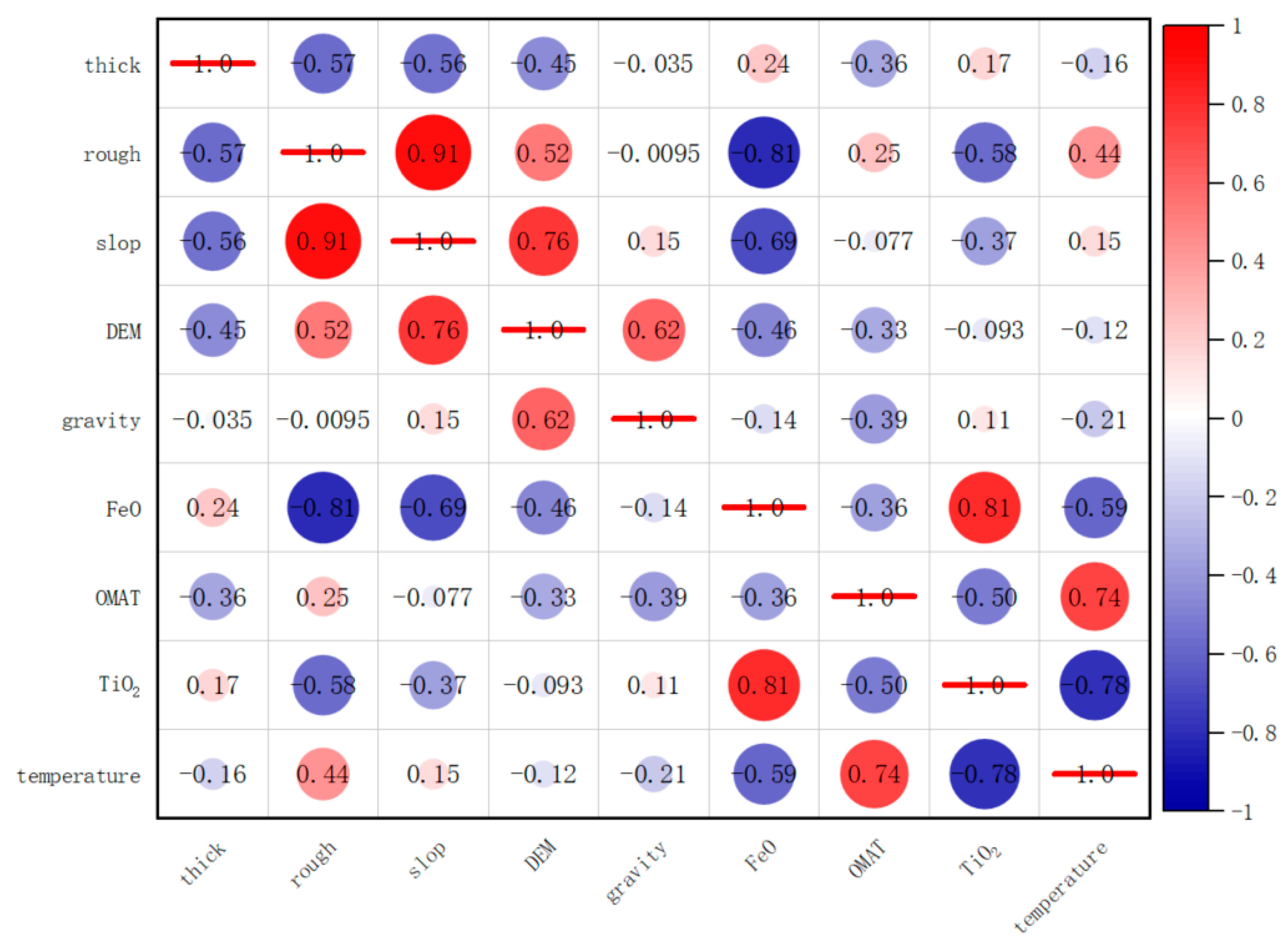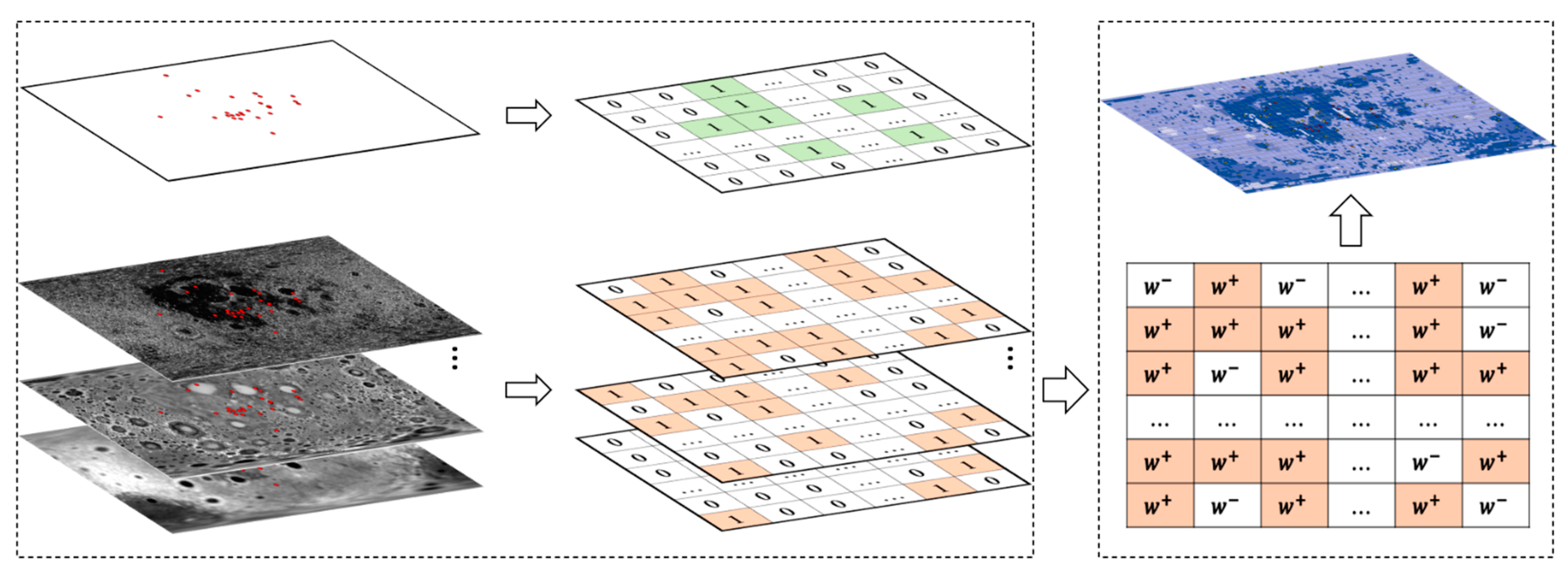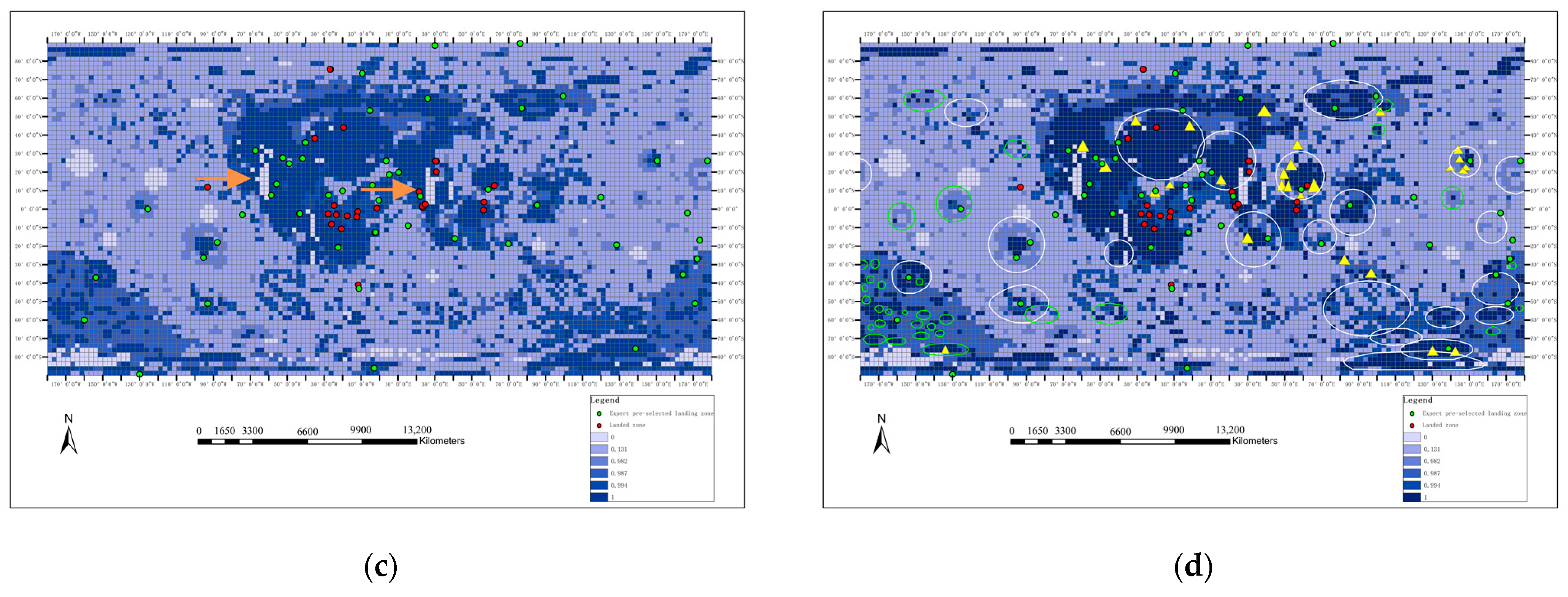Selection of Whole-Moon Landing Zones Based on Weights of Evidence and Fractals
Abstract
:1. Introduction
2. Materials and Methods
2.1. Relevant Work
2.2. Selecting Whole-Moon Landing Zones Based on Weights of Evidence
2.2.1. General Framework
- (1)
- Data input mainly includes two types of data: the evidence layer and the target layer. Since our theme is to screen suitable landing zones for the whole moon, we need to ensure that the resolution and accuracy of the selected data are acceptable for the whole moon. Evidence layers mainly include lunar crust thickness, roughness, slope, digital elevation model, gravity gradient, impact crater radius being iron oxide distribution, and lunar soil optical maturity. Target layers are Apollo (Nos. 11–17), Luna (Nos. 16, 17, 20, 21, 23, 24), Surveyor (Nos. 1, 2, 3, 5, 6, 7), Chang’E 3, Ranger (No. 6–9), CRAIL, and LADEE. There are a total of 50 potential human landing sites in the target layer.
- (2)
- Data preprocessing: grid division on the evidence layer data for the whole moon is performed. After cropping the edge pixels, the mean value of the pixels in each cell is calculated and the correlation coefficient test is carried out on the evidence layer. Then, each evidence layer and the landing point layer are represented by two-state variables, respectively.
- (3)
- Calculation of the weights of evidence: calculate the prior probability of each evidence factor, the weight in each evidence factor cell, and the Bayesian posterior probability and judge the landing suitability of the area according to the final posterior probability in each cell.
- (4)
- Fractal calculation: according to the semi-parabolic distribution in the fuzzy distribution, the complexity of the number of impact craters in each cell is determined by the fuzzy membership degree. According to the total number of cells containing more than the number of impact craters in the cells, the linear regression fitting of the double logarithmic plot is used to determine the threshold, and then the distribution complexity of impact craters in each cell is calculated by the threshold. According to the number complexity and distribution complexity of each cell, the posterior probability calculated by the weights of evidence is changed subsequently.
- (5)
- Result output: the final result is a posterior probability map based on weights of evidence and fractal calculations, which represents the whole-moon landing zones suitability. The manually preselected landing zones and impact crater data are superimposed on it to verify the correctness of the results.
2.2.2. Datasets Introduction
2.2.3. Evidence Factor Selection Based on Correlation Coefficient
2.2.4. Site Selection Method Based on Weights of Evidence
2.2.5. Calculate the Posterior Probability of a Single Evidence Factor
2.2.6. Data Preprocessing
2.3. Optimizing Whole-Moon Landing Zones Based on Fractals
2.3.1. Impact Crater Distribution Complexity Determination
2.3.2. Fuzzy Membership to Determine the Complexity of Impact Crater Number Distribution
2.3.3. Using the Fractal Method to Determine the Complexity of Impact Crater Size Distribution
3. Results
3.1. The Optimized Method of Lunar Zones Based on Weights of Evidence and Fractal
3.2. Landing Zones Analysis Results of Grids with Different Granularities
3.3. Analysis of Suitable Landing Zones in the Pole Region
4. Discussion
- (1)
- The whole-moon landing area optimization method based on the weights of evidence and fractals can delineate the range of suitable landing areas for the whole moon, but its accuracy is limited by the resolution of the original data involved in the calculation, so data with higher precision are required to initiate the calculation.
- (2)
- At present, this method can only use the data of the whole moon for calculation, and this limitation will need to be improved in the future. It needs to be able to calculate any area and select the area that meets the landing conditions within the selected space.
- (3)
- At present, the calculations of the landing areas have not been carried out for specific scientific targets, and only involves a small amount of content such as iron and gravity anomalies. In the future, it is necessary to integrate the 1:2.5 million lunar geological map completed in 2021 [58] and other datasets for further lunar geological scientific research. Future researchers may carry out one or more in-depth scientific research assignments that consider the moon’s geological structure and mineral resources.
5. Conclusions
Author Contributions
Funding
Data Availability Statement
Acknowledgments
Conflicts of Interest
References
- Sutton, R.L. Preliminary Geologic Investigation of the Landing Site: Appendix A: Lunar Surface Orientations of Apollo 17 Rock Samples; National Aeronautics and Space Administration: Washington, DC, USA, 1973. [Google Scholar]
- Zhang, H.; Wang, Q.; Zou, Y.; Ma, J.; Kang, Y.; Zhang, Y.; Liu, J.; Yang, R.; Pei, Z.; He, H.; et al. Overview of lunar exploration and International Lunar Research Station. J. Chin. Sci. Bull. 2020, 65, 2577–2586. [Google Scholar]
- Schaber, G.G.; Sutton, R.L. Lunar locations and orientations of rock samples from Apollo missions 11 and 12. In Proceedings of the Second Lunar Science Conference, Houston, TX, USA, 11–14 January 1971. [Google Scholar]
- Ye, P.; Huang, J.; Sun, Z.; Yang, M.F.; Meng, L.Z. The process and experience in the development of Chinese lunar probe. Sci. Sin. 2014, 44, 543. [Google Scholar] [CrossRef]
- The Lunar Sample Preliminary Examination Team. Preliminary examination of lunar samples from apollo 14. Science 1971, 173, 681–693. [Google Scholar] [CrossRef]
- Liu, J.; Zeng, X.; Li, C.; Ren, X.; Yan, W.; Tan, X.; Zhang, X.; Chen, W.; Zuo, W.; Liu, Y.; et al. Landing Site Selection and Overview of China’s Lunar Landing Missions. Space Sci Rev. 2021, 217, 6. [Google Scholar] [CrossRef]
- Li, C.L.; Liu, J.J.; Zuo, W.; Su, Y.; Ouyang, Z. Progress of China’s Lunar Exploration (2011–2020). Chin. J. Space. Sci. 2021, 41, 68–75. [Google Scholar] [CrossRef]
- Wang, X.H.; Mao, L.H.; Yue, Y.X.; Zhao, J.W. Manned lunar landing mission scale analysis and flight scheme selection based on mission architecture matrix. Acta Astronaut. 2018, 152, 385–395. [Google Scholar] [CrossRef]
- Emmanouil, D.; Ondrej, D.; Aliakbar, E. Location selection and layout for LB10, a lunar base at the Lunar North Pole with a liquid mirror observatory. Acta Astronaut. 2013, 85, 61–72. [Google Scholar]
- Eckart, P.; Aldrin, B. The Lunar Base Handbook: An Introduction to Lunar Base Design, Development, and Operations, 2nd ed.; McGraw-Hill: New York, NY, USA, 1999; pp. 23–64. [Google Scholar]
- Li, Z.J.; Guo, L.L.; Peng, K. Research on Site Selection of Manned Lunar Base. Manned Spacefl. 2015, 21, 158–162. [Google Scholar]
- Yuan, Y.; Zhao, C.; Hu, Z.Y. Prospect of lunar base construction scheme. J. Deep. Space Exploration 2018, 5, 374–381. [Google Scholar]
- Kim, K.J.; Whler, C.; Ju, G.H.; Lee, S.; Rodriguez, A.P.; Berezhnoy, A.A.; Gasselt, S.; Grumpe, A.; Aymaz, R. Korean lunar lander—Concept study for landing-site selection for lunar resource exploration. Int. Arch. Photogramm. Remote Sens. Spat. Inf. Sci. 2016, XLI-B4, 417–423. [Google Scholar]
- Wu, B.; Li, F.; Ye, L.; Qiao, S.; Huang, J.; Wu, X.Y.; Zhang, H. Topographic modeling and analysis of the landing site of Chang’E-3 on the Moon. Earth Planet. Sci. Lett. 2014, 405, 257–273. [Google Scholar] [CrossRef]
- Li, B.; Yue, Z.Y.; Zhang, J.; Fu, X.H.; Ling, Z.C.; Cheng, S.B.; Chen, J.; Yao, P.W. High-Resolution Terrain Analysis for Lander Safety Landing and Rover Path Planning Based on Lunar Reconnaissance Orbiter Narrow Angle Camera Images: A Case Study of China’s Chang’e-4 Probe. Earth Space Sci. 2019, 6, 398–410. [Google Scholar] [CrossRef]
- Jiang, H.K.; Tian, X.L.; Xu, A.A. A new segmentation algorithm for lunar surface terrain based on CCD images. Res. Astron. Astrophys. 2015, 15, 1604–1612. [Google Scholar] [CrossRef]
- Ding, M.; Cao, Y.F.; Wu, Q.X. Passive Image-based Safe Landing Site Searching and Slop Estimation in Probe Landing. J. Astronaut. 2009, 30, 2258–2264. [Google Scholar]
- Liu, S.; Huang, X.F. Design and verification of telecommunication system for Chang’E-4 Lander. Signal and Information Processing, Networking and Computers. In Proceedings of the 7th International Conference on Signal and Information Processing, Networking and Computers (ICSINC), Noida, India, 27–28 February 2020; pp. 527–534. [Google Scholar]
- He, L.; Ren, Q.H.; Feng, Y.J.; Zhang, J.H.; Liu, S.; Chen, S.Y. Real-time Dynamic Addressing for Spacecraft Soft Landing in the Lunar Surface. In Proceedings of the 2015 IEEE International Conference on Information and Automation, Lijiang, China, 8–10 August 2015; pp. 987–992. [Google Scholar]
- Su, Q.H.; Zhao, Y. Analysis method for lunar landers landing safety. J. Beijing Univ. Aeronaut. Astronaut. 2012, 38, 1522–1526. [Google Scholar]
- Liang, S.M.; Wang, Y.B.; Wang, L.W.; Wu, S.; Ji, S. Landing Process of Lunar Lander Simulated with Couple DEM-FEM Model. Chin. J. Solid Mech. 2019, 40, 39–50. [Google Scholar]
- Chen, Z.Y.; Liu, L.; Chen, S.L.; Cui, Y. Interval Uncertainty Analysis of Soft-landing Dynamics of Lunar Lander. Acta Armamentarii 2019, 40, 442–447. [Google Scholar]
- Flahaut, J.; Blanchette-Guertin, J.-F.; Jilly, C.; Sharma, P.; Souchon, A.; van Westrenen, W.; Kring, D.A. Identification and characterization of science-rich landing sites for lunar lander missions using integrated remote sensing observations. Adv. Space Res. 2012, 50, 1647–1665. [Google Scholar] [CrossRef]
- Qian, Y.Q.; Xiao, L.; Yin, S.; Zhang, M.; Zhao, S.Y.; Pang, Y.; Wang, J.; Wang, G.X.; Head, J.W. The regolith properties of the Chang’e-5 landing region and the ground drilling experiments using lunar regolith simulants. Icarus 2020, 337, 113508. [Google Scholar] [CrossRef]
- Lu, Y.; Wu, Y.Z.; Gregory, G.; Ma, J.S.; Cai, W.; Qin, N. Chronological sequence of Ch’ng’E-4 landing zones within Von Kármán crater. Icarus 2021, 354, 114086. [Google Scholar] [CrossRef]
- Di, K.C.; Xu, B.; Peng, M.; Yue, Z.Y.; Liu, Z.Q.; Wan, W.H.; Li, L.C.; Zhou, J.L. Rock size-frequency distribution analysis at the Chang’E-3 landing site. Planet. Space Sci. 2016, 120, 103–112. [Google Scholar] [CrossRef]
- Qiao, L.; Liu, X.Q.; Zhao, J.N.; Yu, W.; Long, X. Geological investigation of Luna 17, Apollo 15 and Chang’E-3 landing sites at Mare Imbrium of Moon. Sci. Sin.-Phys. Mech. Astron. 2016, 46, 029603. [Google Scholar]
- Li, F.; Zhang, H.; Wu, X.Y.; Dong, J. Analysis of Key Characteristics of Lunar South Pole for Landing. Spacecr. Eng. 2015, 24, 103–110. [Google Scholar]
- Wu, W.R.; Yu, D.Y.; Wang, C.; Liu, J.Z.; Tang, Y.H.; Zhang, G.; Zou, Y.L.; Ma, J.N.; Zhou, G.D.; Zhang, Z.; et al. Research on the main scientific and technological issues on lunar polar exploration. J. Deep. Space Explor. 2020, 7, 223–231. [Google Scholar]
- Jennifer, L.; Anthony, C.; Richard, C.; Bussey, B.; McGovern, A.; Beyer, R.; Lees, D.; Deans, M. Site selection and traverse planning to support a lunar polar rover mission: A case study at Haworth Crater. Acta Astronaut. 2016, 127, 308–320. [Google Scholar]
- Zhang, H.; Du, Y.; Li, F.; Zhang, H.; Ma, J.N.; Sheng, L.Y.; Wu, K. Proposals for lunar south polar region soft landing sites selection. J. Deep Space Explor. 2020, 7, 232–240. [Google Scholar]
- Agterberg, F.P.; Bonham-Carter, G.F. Weights of evidence modeling and weighted logistic regression for mineral potential mapping. In Computers in Geology; Davis, J.C., Herzfeld, U.C., Eds.; Oxford University Press: New York, NY, USA, 1993; pp. 3–32. [Google Scholar]
- Cheng, Q.M.; Agterberg, F.P. Fuzzy Weights of evidence method and its application in mineral potential mapping. Nat. Resour. Res. 1999, 8, 27–35. [Google Scholar] [CrossRef]
- Mandelbrot, B. How long is the coast of Britain? Statistical self-similarity and fractional dimension. Science 1967, 156, 636–638. [Google Scholar] [CrossRef]
- Cheng, Q. The perimeter-area fractal model and its application to geology. Math. Geol. 1995, 27, 69–82. [Google Scholar] [CrossRef]
- Xiao, L.; Qiao, L.; Xiao, Z.Y.; Huang, Q.; Qi, H.; Zhao, J.N.; Xue, Z.Q.; Huang, J. Major scientific objectives and candidate landing sites suggested for future lunar explorations. Sci. Sin. Phys. Mech. Astron. 2016, 46, 029602. [Google Scholar]
- Meng, Z.G.; Li, C.; Ping, J.S.; Huang, J.; Cai, Z.C.; Alexander, G. Analysis about landing site selection and prospective scientific objectives of the Von Karman crater in Moon farside. J. Deep Space Explor. 2018, 5, 3–11. [Google Scholar]
- Ma, Z.X. Multi-Pattern Obstacle Detection and Recognition Methods for Lunar Soft Landing; Harbin Institute of Technology: Harbin, China, 2018. [Google Scholar]
- Wei, R.Y.; Ruan, X.G.; Xiao, Y.; Li, J.K. Planetary surface landing area selection based on single image and closed environment avoidance. Syst. Eng. Electron. 2015, 37, 2809–2879. [Google Scholar]
- Liu, C.C. The MRAS evidence weight-based ore prediction for Hongtoushan-type massive sulfide copper deposit in Fushun-Qingyuan area in Liaoning Province. Contrib. Geol. Miner. Resour. Res. 2017, 32, 468–475. [Google Scholar]
- Yao, Y.L. Application of the weight evidence method of lead-zinc metallogenetic prospection prediction in Hongluoshan-Wuzhishan region. World Nonferrous Met. 2018, 2018, 266–268. [Google Scholar]
- Kong, X.; Mi, W.T.; Xin, J.; Chi, H.T.; Hu, J.; Yang, Z.Y. The gold metallogenic prognosis based on the weighting method of evidence in the middle Xuefeng mountain area. Comput. Tech. Geophys. Geochem. Explor. 2019, 41, 832–842. [Google Scholar]
- Kreslavsky, M.A.; Head, J.W.; Neumann, G.A.; Rosenburg, M.A.; Aharonson, O.; Smith, D.E.; Zuber, M.T. Lunar topographic roughnesss from Lunar Orbiter Laser Altimeter (LOLA) data: Scale dependence and correlation with geologic features and units. Icarus 2013, 226, 52–66. [Google Scholar] [CrossRef]
- Barker, M.K.; Mazarico, E.; Neumann, G.A.; Zuber, M.T.; Haruyama, J.; Smith, D.E. A new lunar digital elevation model from the Lunar Orbiter Laser Altimeter and SELENE Terrain Camera. Icarus 2015, 273, 346–355. [Google Scholar] [CrossRef]
- Lucey, P.G.; Blewett, D.T.; Taylor, G.J.; Hawke, B.R. Imaging of lunar surface maturity. J. Geophys. Res. 2000, 105, 20377–20386. [Google Scholar] [CrossRef]
- Wieczorek, M.A.; Neumann, G.A.; Nimmo, F.; Kiefer, W.S.; Taylor, G.J.; Melosh, H.J.; Phillips, R.G.; Solomon, S.C.; Andrews, J.C.; Asmar, S.W.; et al. The crust of the Moon as seen by GRAIL. Science 2013, 339, 671–675. [Google Scholar] [CrossRef]
- Ling, Z.C.; Zhang, J.; Liu, J.Z.; Li, B.; Wu, Z.C.; Ni, Y.H.; Sun, L.Z.; Chen, J. Lunar global FeO and TiO2 mapping based on the recalibrated Chang’ E-1 dataset. Acta Pet. Sin. 2016, 32, 87–98. [Google Scholar]
- Williams, J.P.; Paige, D.A.; Greenhagen, B.T.; Sefton, E. The global surface temperatures of the Moon as measured by the Diviner Radiometer Experiment. Icarus 2017, 283, 300–325. [Google Scholar] [CrossRef] [Green Version]
- Zhang, C.; Chen, J.P. Advances in the study of automatic identification and classification of lunar impact craters. J. Geol. 2019, 43, 514–522. [Google Scholar]
- Cheng, Q.M.; Chen, Z.J.; Ali, K. Application of Fuzzy Weights of Evidence Method in Mineral Resource Assessment for Gold in Zhenyuan District, Yunnan Province, China. Earth Sci. 2007, 2007, 175–184. [Google Scholar]
- Cheng, Q.; Agterberg, F.P.; Ballantyne, S.B. The separation of geochemical anomalies from background by fractal methods. J. Geochem. Explor. 1994, 51, 109–130. [Google Scholar] [CrossRef]
- Cao, L.; Cheng, Q.M.; Chen, Z.J. Generalized self-Similarity theory and models. J. Earth Sci. 2009, 34, 270–274. [Google Scholar]
- Cheng, Q.M. Spatial self-similarity and geophysical and geochemical anomaly decomposition. Prog. Geophys. 2001, 16, 8–17. [Google Scholar]
- Wu, W.; Mao, C.J.; Zhang, X.C.; Liu, H.L.; Zhang, F.; Wang, H.F.; Li, H.N. Improvement of saturation correction method based on linear regression. Prog. Geophys. 2020, 35, 1888–1893. [Google Scholar]
- Liu, G.Z.; Wei, W.; Fu, L.Y.; Sun, W.J. Seismic resolution analysis based on least squares migration. Program Geophys. 2020, 35, 2171–2180. [Google Scholar]
- Cao, Y.Q.; Wang, Y.Z.; Lu, P.Y. Research on automatic evaluation for key parameter of anomaly decomposition of metallogenic background based on machine learning. Prog. Geophys. 2021, 36, 1226–1235. [Google Scholar]
- Stuart, J.R. A New Global Database of Lunar Impact Craters >1–2 km: 1. Crater Locations and Sizes, Comparisons with Published Databases, and Global Analysis. J. Geophys. Res. Planets Sect. 2019, 124, 871–892. [Google Scholar]
- Ji, J.; Guo, D.; Liu, J.; Chen, S.; Ling, Z.; Ding, X.; Han, K.; Chen, J.; Cheng, W.; Zhu, K.; et al. The 1:2,500,000-scale geologic map of the global Moon. Sci. Bull. 2022, 67, 1544–1548. [Google Scholar] [CrossRef]










| Evidence Layers | Resolution | Range | Data Sources |
|---|---|---|---|
| Slope | 60 m | Whole moon | [44] |
| Roughness | 1.8 km | Whole moon | [43] |
| DEM | 60 m | Whole moon | USGS |
| Gravity gradient | 1200 a | Whole moon | NASA |
| FeO | 400 m | Partially | [47] |
| Lunar crust thickness | 60 km | Whole moon | [46] |
| OMAT | 200 m | Whole moon | [45] |
| Database of 5–20 m impact craters | 5–20 m | Whole moon | [57] |
| Posterior Probability | Number of Occurrences of Landing Sites (Red Points) | Statistical Probability | Number of Occurrences of Expert Pre-Selected Points (Green Points) | Statistical Probability |
|---|---|---|---|---|
| 1.000 | 29 | 0.580 | 27 | 0.587 |
| 0.999 | 13 | 0.260 | 11 | 0.239 |
| 0.112 | 8 | 0.160 | 4 | 0.086 |
| 0.000 | 0 | 0.000 | 4 | 0.086 |
Publisher’s Note: MDPI stays neutral with regard to jurisdictional claims in published maps and institutional affiliations. |
© 2022 by the authors. Licensee MDPI, Basel, Switzerland. This article is an open access article distributed under the terms and conditions of the Creative Commons Attribution (CC BY) license (https://creativecommons.org/licenses/by/4.0/).
Share and Cite
Cao, Y.; Wang, Y.; Liu, J.; Zeng, X.; Wang, J. Selection of Whole-Moon Landing Zones Based on Weights of Evidence and Fractals. Remote Sens. 2022, 14, 4623. https://doi.org/10.3390/rs14184623
Cao Y, Wang Y, Liu J, Zeng X, Wang J. Selection of Whole-Moon Landing Zones Based on Weights of Evidence and Fractals. Remote Sensing. 2022; 14(18):4623. https://doi.org/10.3390/rs14184623
Chicago/Turabian StyleCao, Yaqin, Yongzhi Wang, Jianzhong Liu, Xiaojia Zeng, and Juntao Wang. 2022. "Selection of Whole-Moon Landing Zones Based on Weights of Evidence and Fractals" Remote Sensing 14, no. 18: 4623. https://doi.org/10.3390/rs14184623







